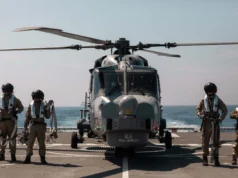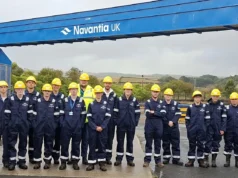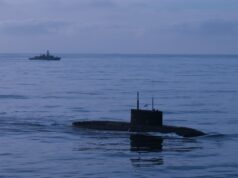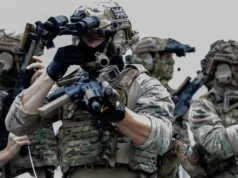The Fleet Solid Support programme has passed its Critical Design Review, marking the transition from design to full production of the Royal Fleet Auxiliary’s next-generation supply ships, the Ministry of Defence and Navantia UK announced.
The review examined the detailed design of the vessels, including hull structure, safety systems, environmental sustainability and integration of military equipment. Completion of this stage allows production to begin on the three 216-metre ships, which will provide stores and munitions to Royal Navy vessels at sea.
Keith Bethell, Director for the Maritime Environment at Defence Equipment and Support, visited the Harland & Wolff yard in Belfast to mark the milestone. “I was impressed by the scale of transformation underway in Belfast, seeing firsthand how we will deliver this world-class capability and meeting individuals central to the programme,” he said. “This important milestone brings us closer to ensuring the RFA can support our naval operations worldwide while strengthening sovereign shipbuilding for years to come.”
The review follows last year’s Preliminary Design Review and comes as the Belfast yard continues its modernisation under Navantia UK, which acquired Harland & Wolff in 2025. British and Spanish technical teams have collaborated on the design through a knowledge transfer programme involving work at both Belfast and Cádiz.
Navantia UK Chief Executive Donato Martínez said “CDR confirms the hard work and collaboration between MOD, BMT and Navantia UK. This milestone demonstrates that the programme is ready to meet its operational, logistical and efficiency needs as it gears up to deliver for the Royal Navy and RFA.”
According to the Ministry of Defence, the three ships will be the largest UK military vessels other than aircraft carriers and will enhance the UK’s carrier strike and replenishment capabilities.
BMT, which developed the functional design, said the ships incorporate energy-saving and emission-reduction technologies in line with the Royal Navy’s Net Zero 2050 objectives. “We are proud to have collaborated with Navantia UK and MOD to provide a safe, secure and environmentally conscious design,” said Catriona Savage, BMT’s FSS Programme Director.
Navantia UK said the milestone aligns with its commitment to rebuilding sovereign shipbuilding capacity. The company recently welcomed 73 new apprentices, bringing its total to 222, representing 20 percent of its workforce. It plans to create 500 additional apprenticeships by 2030 as part of efforts to strengthen the UK’s maritime industrial base.














oh good its part of net zero! as if thats really important in defence matters. Who cares about it doing the job
Absolutely, who cares if the planet remains habitable to humans or not… 🤦🏻♂️
Great news. It will be interesting to hear more about the innovations going into the design to accommodate the Royal Navy’s Net Zero 2050 objectives, a worthy cause. The sooner we reduce our reliance on the fossil fuel products of our enemies and our business competitors, the better, particularly when defence is in question.
Just get on and build them now please.
Good news. So when will they actually stop grandstanding about years to come and net zero and actually start building? We have had almost a decade of talking it is beyond frustrating now.
I’d have had them built in Korea years ago and in service already but that’s just me.
You and a lot of other people TBH.
They were needed ages ago.
That said the Tides were not quite so smooth into service as some have suggested.
The Tides ebbed and flowed into service?
😁😁
Hi SB and Daniele, I’m in 2 minds about this one, it’s all down to short term vs long term needs.
YES buying these from S Korea would result in a faster and cheaper build, but as the design has only passed its Critical Design Review they wouldn’t already be in service. Going forwards they’d definitely have their Roller Skates in the build process however the risk is S Korea hasn’t ever built a replenishment shop of this size or complexity. And as you mentioned the Tides haven’t been without their issues.
TBH if money was available I’d be thinking about ordering 2 smaller RFA ships from S Korea as a stop gap and to supply all our other surface warships. Personally I’d go for a clone of the RNZN Aotearoa, as a design she’s a little cracker (Polar class 6) and brings a lot of fringe capabilities. Yes I’m biased as she just happens to be the largest ship ever built to a RR Marine environship design (now closed down after being bought by Konsgerg).
On the other hand NO because it doesn’t enable the regeneration of a large shipbuilding capability in the U.K which we do actually, nor does it ease the future maintenance issues. Put simply not regenerating building capability at Belfast means nowhere to build MRSS in U.K and IMHO and far more importantly it means the QE’s are still restricted to using Rosyth.
Nowhere else in UK still has the space, Gantries, build docks and that massive dry dock it’s all just sat there, we Taxpayers funded them and we’d be silly not to get them back into use.
Regenerating Belfast brings us so many fringe benefits and having our Carriers with a single point of failure is eliminated.
I do realise that Inchgreen would be an alternative but it would require far more investment, their is already a skills shortage and the lack of support for Military Shipbuiilding doesn’t inspire me with enough confidence to put all our Eggs in the SNP’s basket.
Hi mate.
A sensible post at last.
The money probably wasn’t there anyway
So you don’t really care about British jobs
I’ll reverse that. You don’t really care about the British military having assets.
There….both statements are daft, aren’t they.
I care for both, but the military more. Not every asset needs to be home built when military need should take precedence.
Personally I’d prefer that everything we bought was made in Britain by British Workers using British materials.
But the realistic chance of that happening ceased to exist back in the Stone Age.
Ugg Ugg, flobble wobble.
(made that up, sort of what we would have spoken like back then ! Good init bro ?)
Must have a shave, too hairy by far.
If we want British jobs it would be a good idea if we had a government who supported British industry instead of being hell bent on destroying it. We have record bankruptcy’s,the highest unemployment for years and falling vacancies. Not bad for fifteen months!
Yes but not in the Defence Industries we don’t, in fact just the opposite because other than a potential shortfall in work for Aero (BAe and Leonardo) everywhere else is absolutely booming !
BAe, AEWR, Babcock, Thales, MBDA, SFM, RR, BMT, Navantia H&W are all receiving huge investment, taking on Apprentices and upskilling their existing workforce. In fact we have a shortage of skilled workers in many areas of the Defence industry and especially in the DNE !
As for the rest of UK industry I’d probably agree with a lot of what you say, the NI increase has crucified a lot of SME’s. But as this article is about a positive investment in the U.K Defence Industry and its booming I’ll support this stance (I just wish they’d pull their fingers out and issue the DIP).
I’m not sure how F35, Typhoon, FSS, MRSS T26, T31, T45 upgrades, T83 , Astute, ARKUS, Dreadnought and many many more projects isn’t supporting British Industry
You obviously don’t read or watch the news Robert.
…and you’re right!
I would go to say I would have had them build int the Uk years ago.. to ensure we had a large surface unit yard.. this is a long term HMG balls up.. in reality it was a simple unwillingness to invest in British shipbuilding and saving some pounds in year not an urgent need that lead the Cameron government to get these build outside of the Uk.. it’s was pure neoliberal dogma ( that thing that’s has lead to the west having the problem it now has.. china). So in regards to our auxiliary tankers, we have the wave class as a very good core and they could keep orange leaf going no problem for a few more years as well as black and gold rover.. infact in the mid 2010s they had more operational tankers than they do now.. so there was no rush or dire emergency at that point.. they could have used a 4 tanker build to regenerate a UK yard ready for the solid stores ship and MRSS.. HMG knew that from 20112 to about 2035 it was going to need to build 12 20,000-40,000 ton auxiliaries.. essentially a steady drumbeat of one every 2 years.. any government worth its salt would have taken that opportunity to regenerate a major shipbuilding yard.. but Cameron and Osborn were neoliberal idiots and to them using the market to save a few quid was far more important than the development of a geostrategic asset like a shipyard that could secure a sovereign ability to build large auxiliary warships..what we could have had was a decade ago Belfast building the tides..then in 2020 moving to the solid stores ships.. then in 2026 moving to MRSS..
That’s what should have happened if we had not had 25 years of governments that are incapable of thinking in terms of geostrategic need and long term risk vs gain.
Hi Jonathan yep 90% is bang on it pretty well lines up with my input. But I just don’t think extending the Leaf and Rovers would have been an option as they were all 30 + years old, pretty well clapped out and more importantly they were all single skin hulled so not MARPOL or U.K / EU compliant.
Hi ABC they probably could have scraped out A year or two more.. commercial ships tend to be a bit more easy to do that… the single skin issue was something HMG could just say whatever for a bit.. after all the last leaf and rover were not decommissioned until 17/18… I would say they had a couple of years give… just wanted cheap in year.
There’s an interesting piece on CNN from October 21st about how Korean yards are so efficient, and moves by Hanwha and Hyundai to improve US shipbuilding: one has bought a US yard and is investing $5bn in upgrading it. South Korea might be able to solve the disaster that is US Naval shipbuilding.
Well if you want a shipbuilding and the skills you need to get them built in the uk ,you could also take your attitude and have all the frigates built abroad they would be done in half the time.
No, because we had the available shipyards who needed the work to build our escorts which are always built in the UK, which is fine.
With FSS, the yards were all booked full of work, there was no one to build them previously, and the military has subsequently gone without. It is taking years to regenerate Belfast.
We’re you another one who expected the new government what ever party too put right 14 years of chaos.
No, never voted Labour in my life. And never will.
Always knew you were a secret Green voter 😉
Of course they should have entered service years ago, it’s been farcical having one elderly and now non-functional replenishment ship. But on the bright side, the new ships have the green light.to.get building and we have a UK yard being modernised and brought back into service, which is great for UK shipbuilding, jobs and defence resilience.
Looking at the bigger picture, the RN has somewhere between 27 and 31 new ships and subs planned to be built over the next ten years, which is a considersble6 drumbeat, as long as HMG can afford it. There will be more than enough work to keep 5 main yards building. H&W has to be the front runner for the MRSS, whether that turns out to be 3 ships or 6.
Do we know what sort of defensive armament is envisaged for the FSSS? It is going to be a big valuable ship and I hope will be able to.defend itself beyond having a couple of 30mm guns for last-ditch defence.
Those 30mm guns are the weapons of choice against Giant Killer Tomatoes though.
Ok it’s urgent that steel is now cut and the keels laid up.. money needs to be pumped to get these build ASAP.. not just as we need them yesterday.. but because we need to yard cleared so they can build the MRSS large amphibious vessels.. because now we have flogged Bulwark and not put her in service for the next 6 years we have a huge gap in how we can re-enforce the northern flank.
“Northern Flank” ? What, you mean Them pesky Scots are causing trouble again ? Get some Brickies on that Wall again, that’ll stop them Gingers in skirts.
It won’t happen due to the cost increase, but what they really should be doing with these is creating a humanitarian relief platform. Big solid stores would be ideal for it, just need space for a helictor or two and a hanger. Plus an order of enough that we have one available at all times to support the carrier and another at high readiness for such a role. Potentially with a iso container style hospital option.
Would really boost the UK soft power, at very little increased cost.